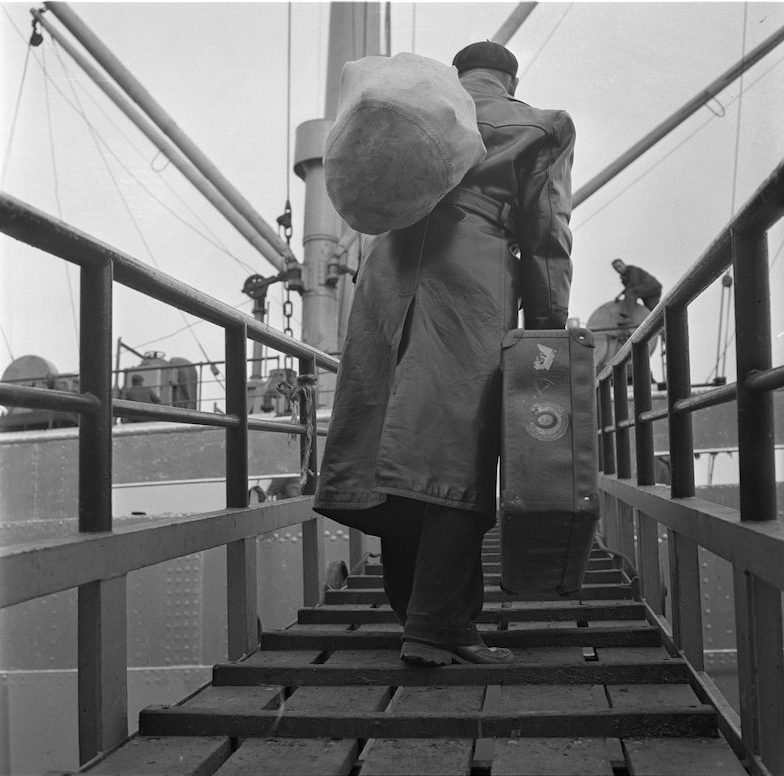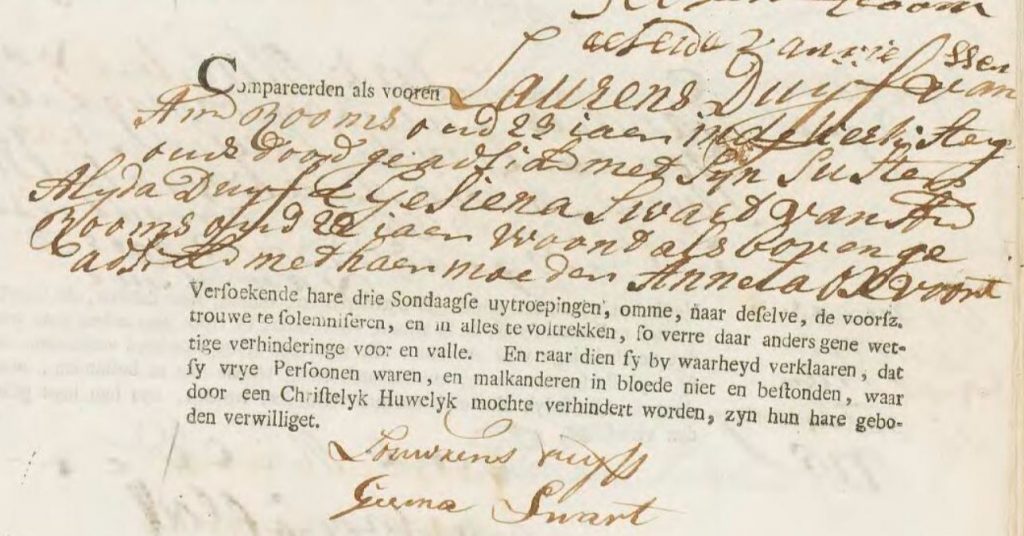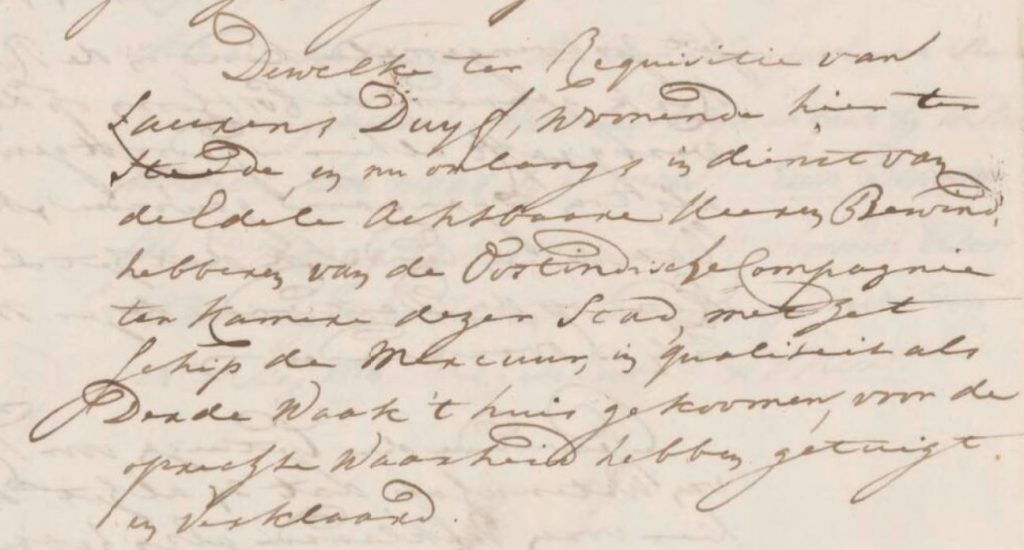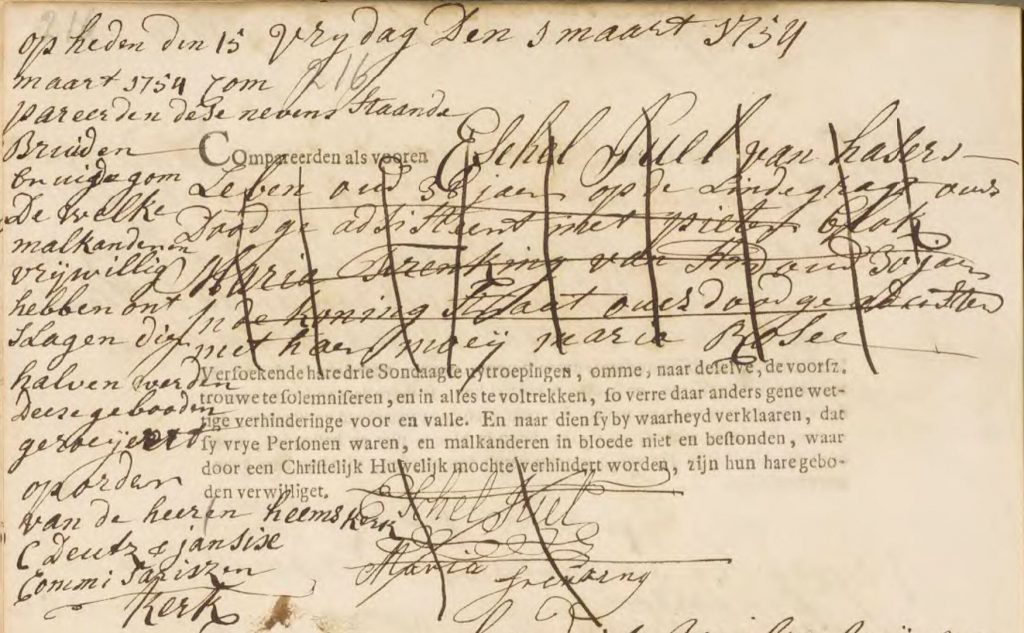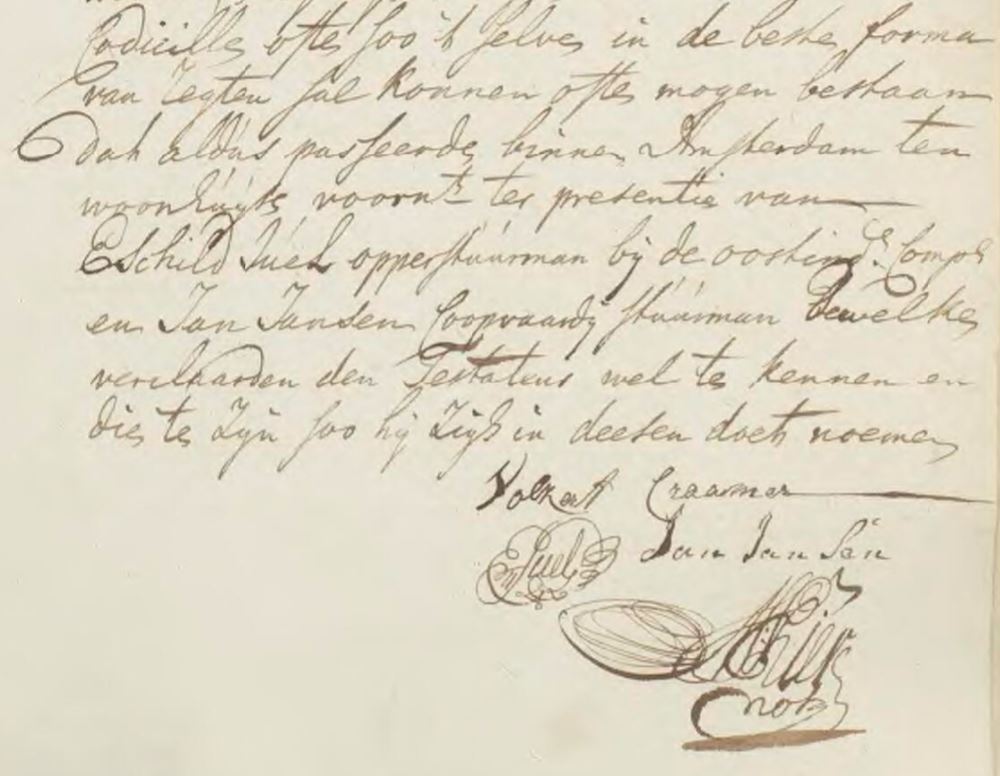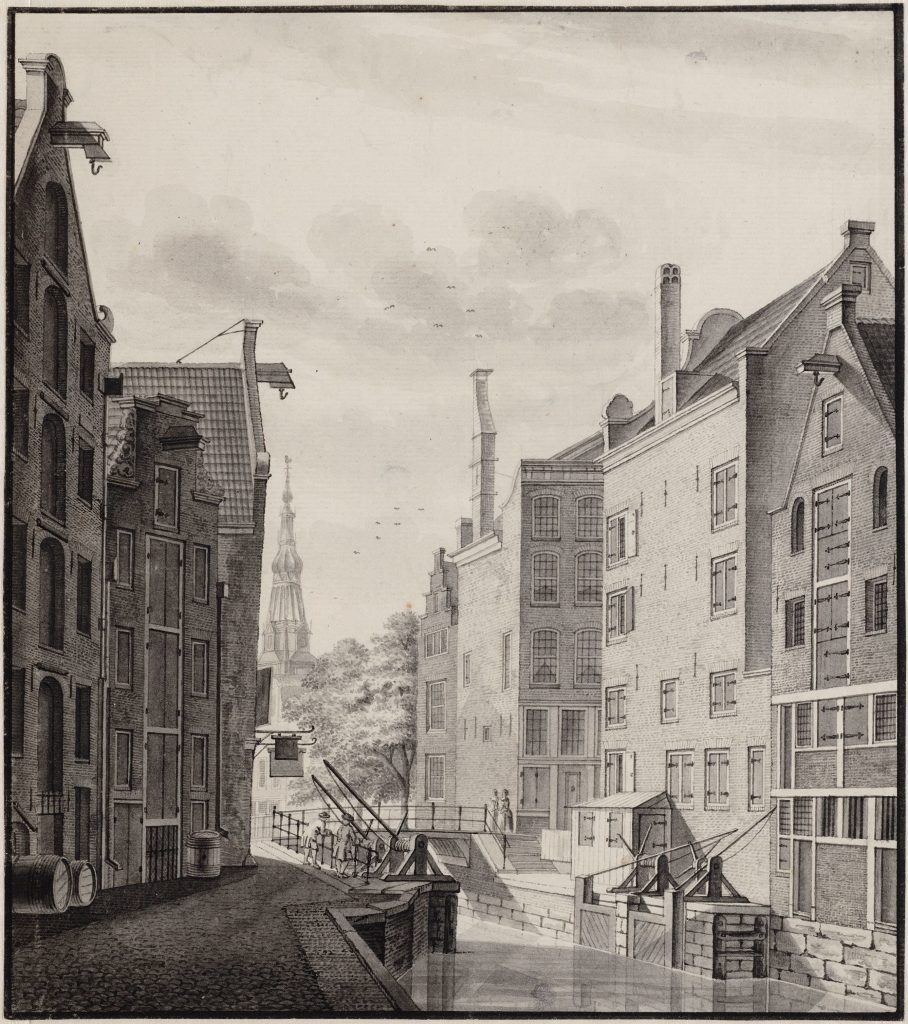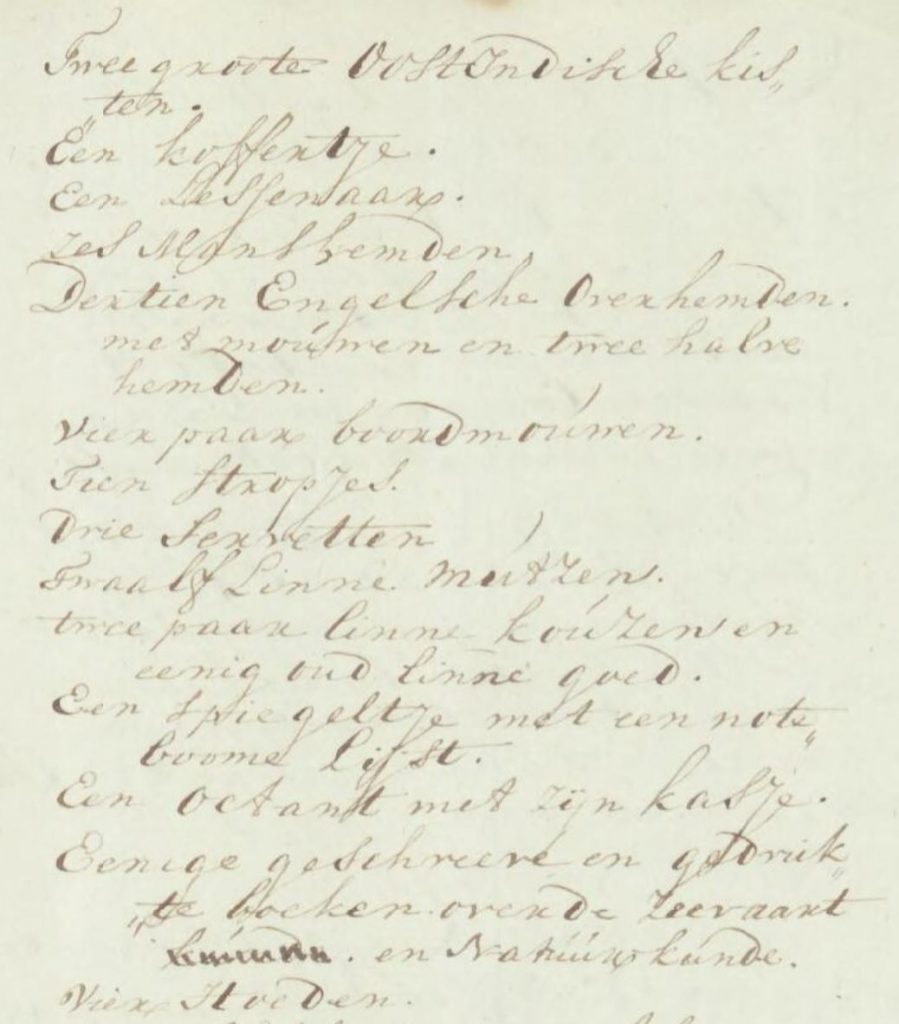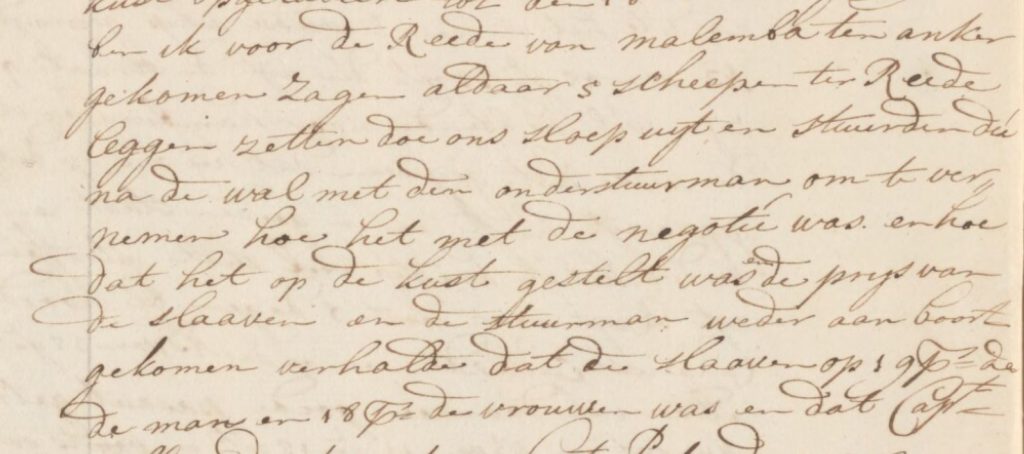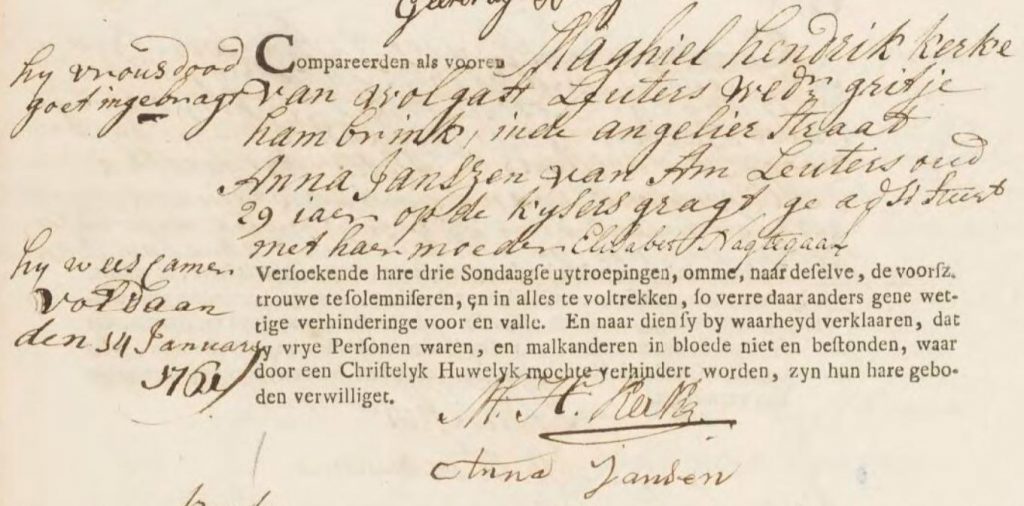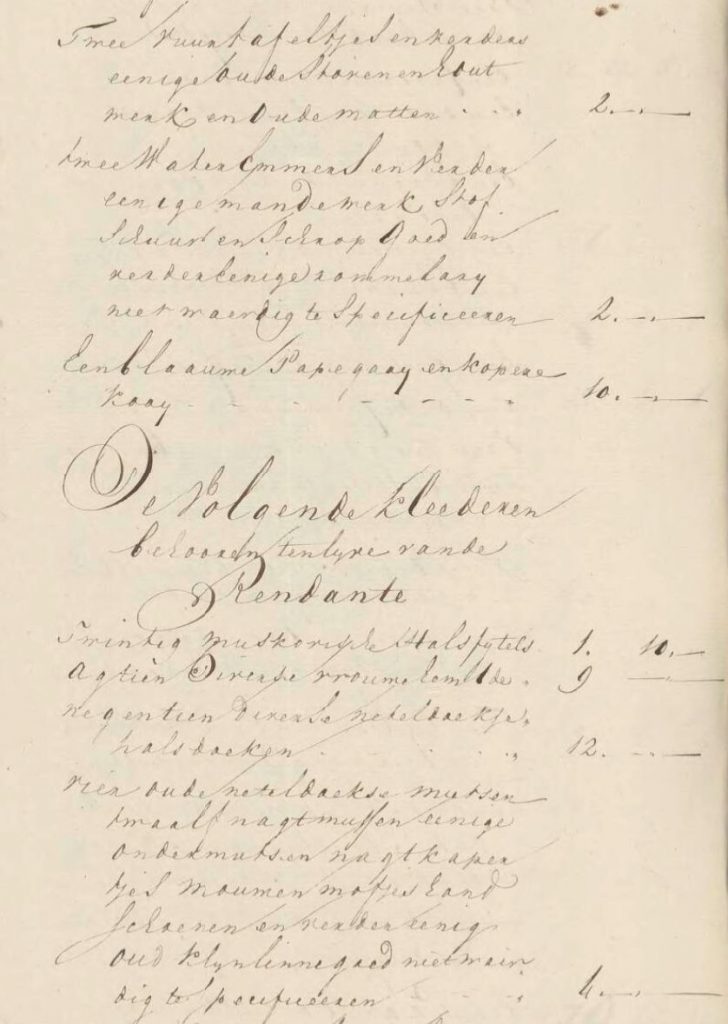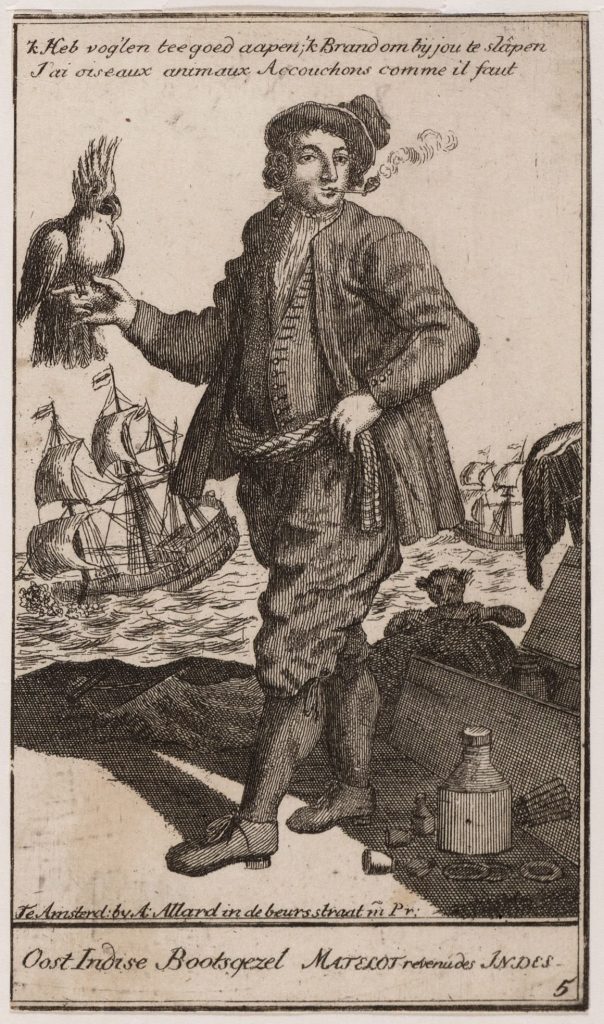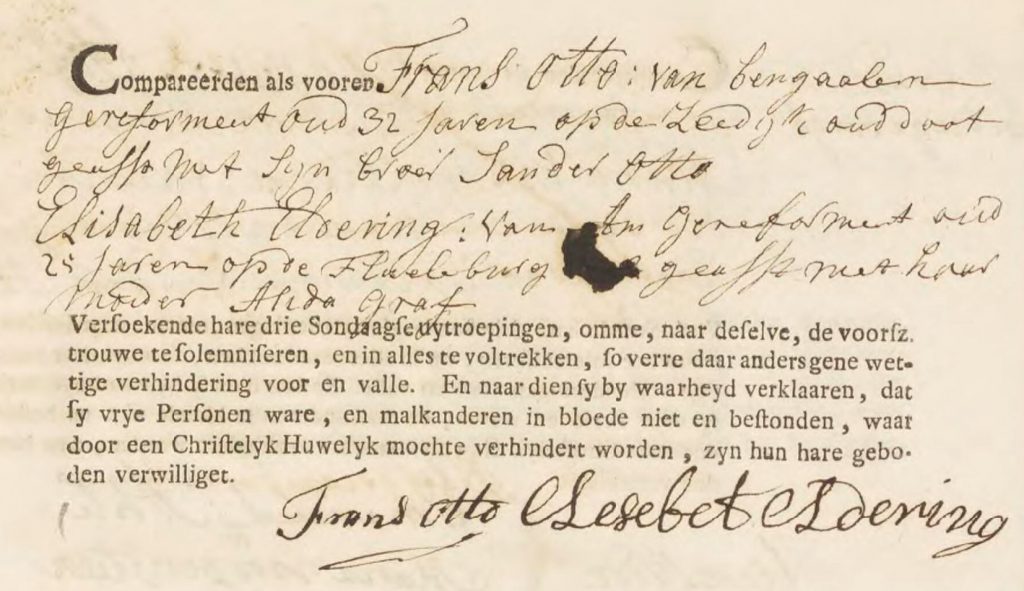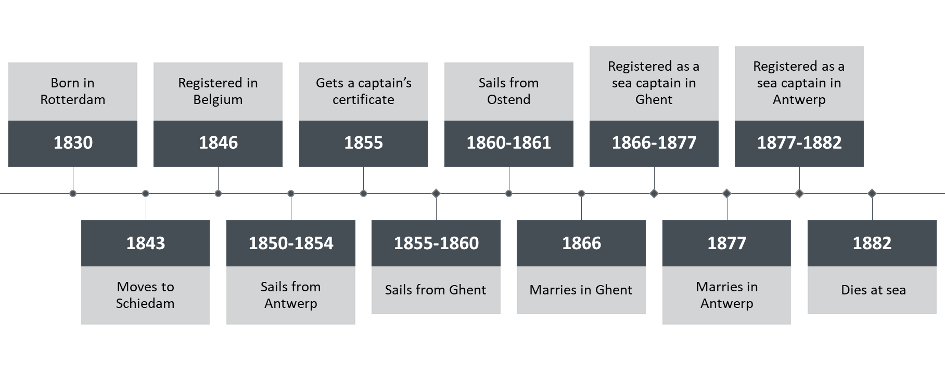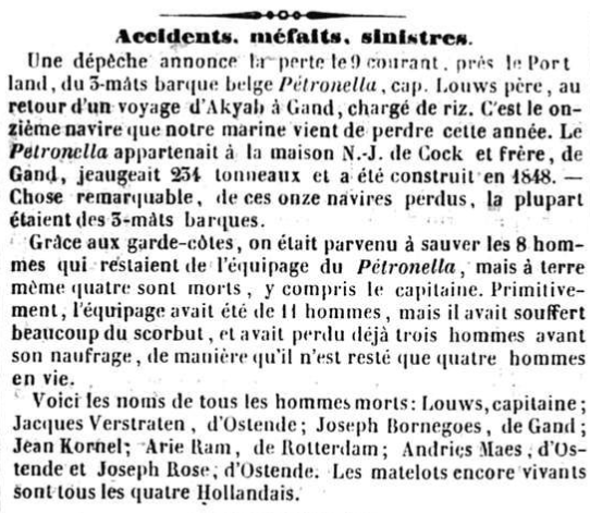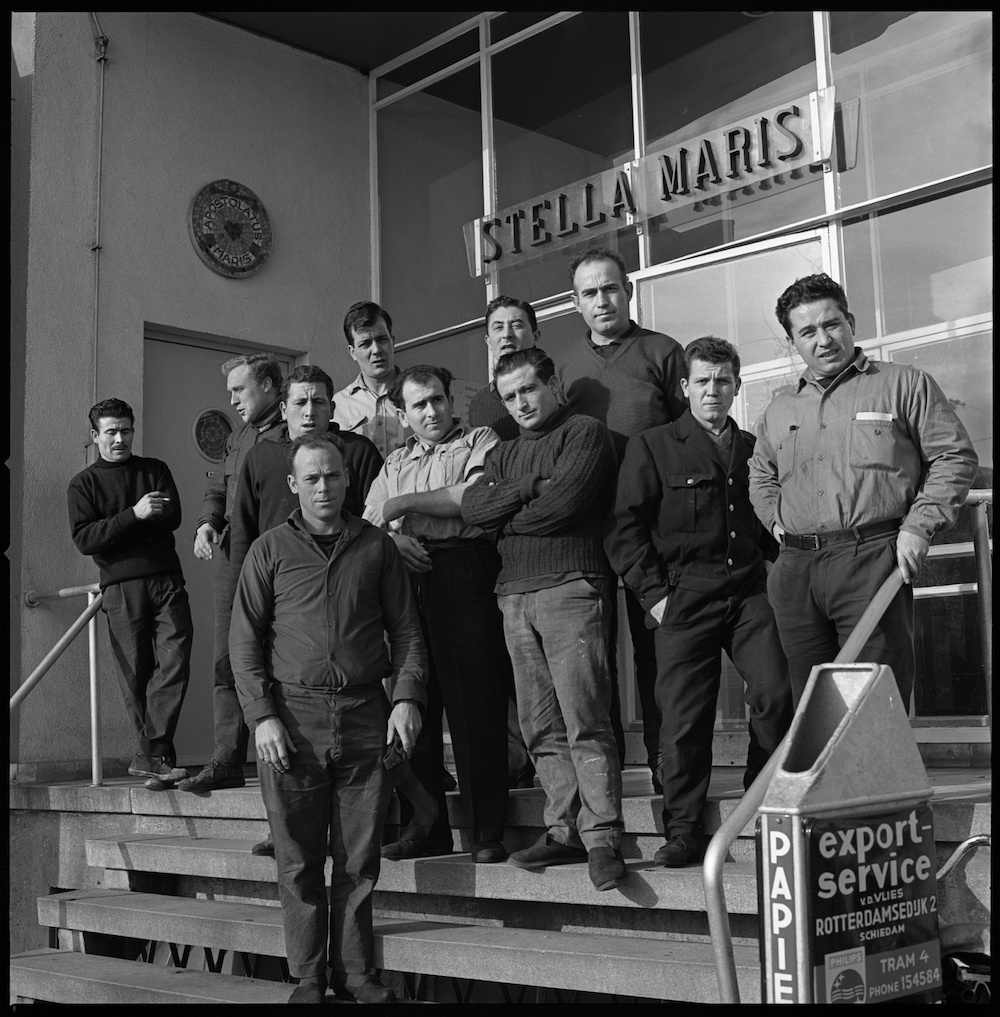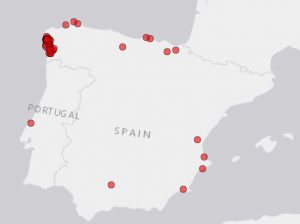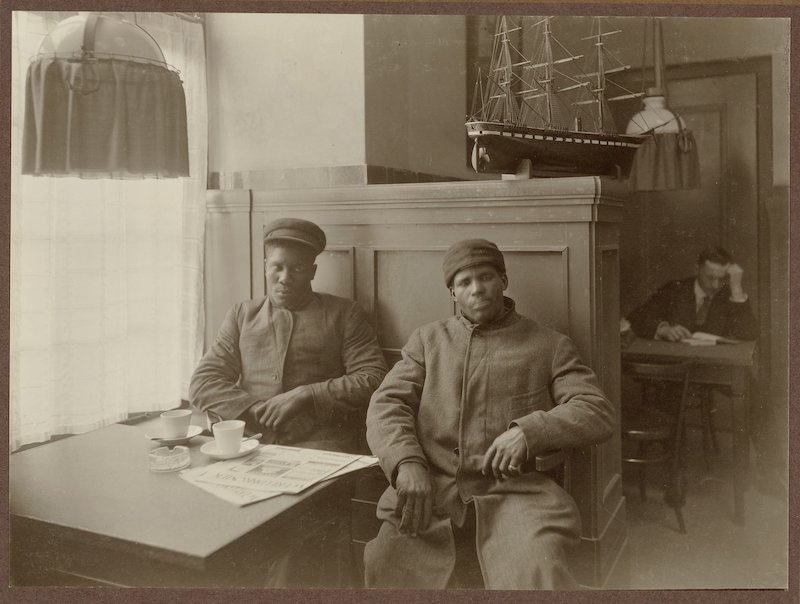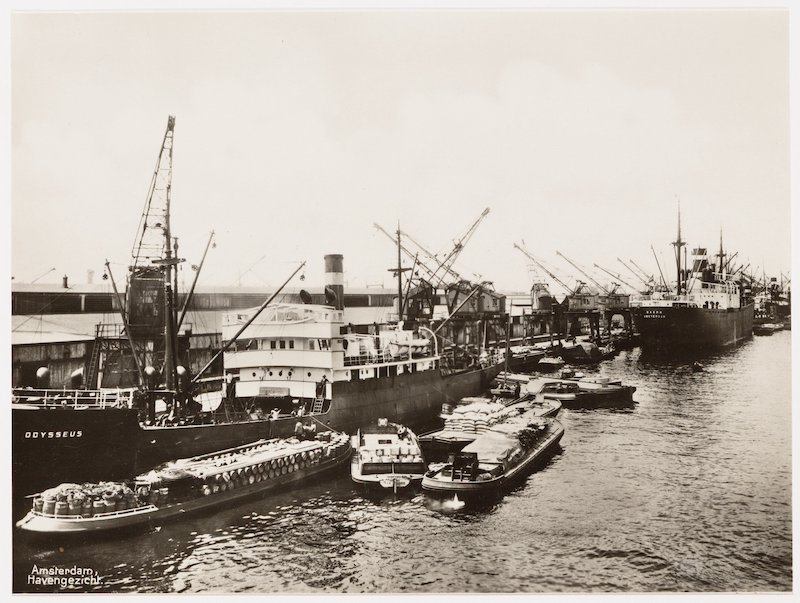Sailor’s lives
Table of contents
Table of contents
On this page, we present a collection of sailor’s lives—short biographies, in which we explore the lives of individuals and small groups in the data sets we work with, such as the VOC pay ledgers and records of Dutch shipping companies from the 19th and 20th century.
Introduction
Seaborne trade is the backbone of the world economy. According to 2018 figures of UNCTAD, the United Nations Conference on Trade and Development, around 80 percent of global trade (by volume) is carried by sea. The workforce manning the shipping sector is small by comparison, however, and largely invisible: ships usually only moor for a very short time for loading and unloading, giving their crews little opportunity to go ashore, stroll around and be seen.
This used to be different. Back in the days when harbors were still often located close to city centers, and ships remained in port for at least a few days, the streets, bars and brothels of port cities were full with sailors. But then as now, seafarers were a relatively anonymous class of workers.
Anonymous and nowadays largely invisible, but sailors are nonetheless a fascinating class of workers. What makes them so interesting is, above all, their international character. Ship crews often consist of many different nationalities. This is true for the container ships and oil tankers of today, and also for the ships of the past: on Dutch East Indiamen in the 18th century, for example, Dutch-born seamen were often a minority.
The international composition of ship crews makes it possible to investigate whether promotion chances of native and foreign-born seamen differed—our curiosity about this is what started the research behind this weblog (see HUMIGEC project and blog posts on our methodology for reconstructing sailor’s careers). Naturally, it doesn’t stop there. The international crews bring other questions to the fore. How do seamen of different nationalities work and live together on board? To what extent do crew members of different nationalities actually differ from each other? Is it just their nationality that is different, or also their background? How are boarding a ship in a foreign country and migrating connected? And how have things changed over time?
Why biographies?
While quantitative data, for example from sources such as the VOC pay ledgers, the Prize Papers and shipping companies’ records, provide a very good basis for our research, they do not provide answers to all questions. We often find ourselves in need of knowing a bit more about the sailors in our data sets.
The literature provides some background information. For crew members of the VOC, we have the work of Roelof van Gelder on Georg Naporra (Naporra’s omweg, 2003) and, together with Vibeke Roeper, In dienst van de Compagnie: leven bij de VOC in honderd getuigenissen (1602-1799) (2002), which contains fragments from written sources of 100 sailors and soldiers. Books like Eigendomsstrijd by Karwan Fatah-Black (2018) also contain scattered biographies of seamen (in this case of Surinamese sailor Benjamin Coffij).
This is relevant and helpful, but insufficient for our research. There is probably a bias in the selection of sailors in Van Gelder’s works, for example, as these men have all left written sources. We therefore set out to collect additional background information for some (groups of) seafarers who sailed on ships of the Dutch merchant marine. We present the results of this research—a collection of short biographies with images of original source documents—on this webpage. This is a dynamic collection: we will add new entries over time.
Credits
These biographies were researched and written by Jessica den Oudsten and Daniël Tuik. Jelle van Lottum and Lodewijk Petram wrote the introduction and discussion paragraphs. Kristof Loockx contributed the story on Willem and Pieter Louws, two Dutchmen who sailed on Belgian vessels. See About us for short biographies of the authors.
18th century
Dutch (or second-generation migrant) sailors
Laurens Duijff (1753-<1785)
Dutch-born seafarer of Scandinavian descent, father and brother were also seafarers, chose to pursue a maritime career in Asia.
Some crew members of the Dutch East India Company (VOC) stayed in Asia for a longer period of time, either working on ships that sailed between Asian harbors or in one of the VOC strongholds ashore. Most of them would eventually return to Europe, or die while they were still employed by the VOC in Asia. Only very few chose to leave the company’s service in Asia. Laurens Duijff did so, however. His pay ledger record states that he joined the merchant marine in Asia. We tried to find out more about him.
Laurens Duijff was the son of the Norwegian captain Pieter Duijff (c.1724-<1772) and Christina Swart (1730->1772). Pieter Duijff had been born in Mandal in Norway and married Swart in Amsterdam in 1752. Swart was also of immigrant descent: she was the daughter of Laurens Christiaanse Swart (c.1692-unknown) and Aaltje Machielse (c.1691-unknown), who had both migrated from Norway to Amsterdam. One year after the marriage of Duijff and Swart, their son Laurens was born. He was the eldest of at least seven children.
Laurens followed in the footsteps of his father, who was a captain on the merchant marine, mainly sailing on the route between Amsterdam and Hull in England.[i] In 1771, Laurens and his brother Pieter worked as sailors on the ship Holland on a voyage to Hull and back.[ii]
Shortly after this voyage, in May 1772, Laurens left the merchant marine and joined the VOC. During his first voyage, he was a gunner’s mate on the Westerveld.[iii] He returned to Amsterdam two years later. It is unknown what he did careerwise between 1774 and 1776, but there were some important developments in his personal life. In January 1776, a son of Laurens Duijff and Gesina Swart was baptised in the Roman Catholic Church De Posthoorn. He was named Robertus.[iv] Robertus was ‘illegitimus’, meaning that he was born out of wedlock. A little more than a month later, in February 1776, Duijff and Swart registered their marriage after all. Both were in their early twenties and lived in the Kerksteeg in Amsterdam.[v]
In January 1777, Duijff started his second VOC voyage, this time as a third mate on the ship Mercuur. This was quite an improvement compared to his last job as gunner’s mate. As a third mate, he was responsible for the navigation of the ship and he probably had passed an exam in order to qualify for this position. After a successful voyage, he returned to Amsterdam in June 1778.
This time, an unpleasant surprise awaited Duijff when he returned home. He did not just find his wife and his son there, but also a baby boy. Duijff had been away for almost seventeen months, so the baby could not have been his. He was clearly unhappy with the situation. In July, Jacoba van Gijsen (1743-1798), a midwife, and her sister Martha van Gijsen appeared for notary Nathanael Wilthuijzen (1733-1793). They were both asked by Duijff to declare that they had been present at the birth of Swart’s son. They confirmed that they had been there, on Sunday 23 February 1778, and stated that Swart had declared on multiple occasions, also during childbirth, that the father of the child was a man called Harmanus Claase. They also declared that they knew that the boy had been baptised two or three days after his birth in Roman Catholic Church De Posthoorn on the Brouwersgracht, and was named Matthijs Claasse.[vi] Sadly, Matthijs only lived for a few months and died on 13 July 1778, a little more than a month after Duijff had arrived home.
Despite the death of Matthijs, Duijff still decided to go to the notary and had a deed drawn up about the misstep of his wife. A deed like this could be used as evidence in a court case, with the goal of getting a separation. Adultery was one of the few valid reasons for a separation from bed and board.[vii] It seems that Duijff intended to go to court or was already involved in a court case: before his departure on his third VOC voyage, he authorized Jan Jacob Stapel (who was an attorney) to take care of his legal matters.[viii]
In January 1779, Duijff left Amsterdam for his third and final VOC voyage. When the ship arrived in Batavia, Duijff made an important decision: he decided not to return home, but to enlist on the merchant marine ship Cornelia Adriana. He got permission to leave the VOC. This was a conspicuous decision, because the working conditions in Asia were even harsher than in Europe, especially for European men. They were not used to the climate and tropical diseases killed large numbers of them. Perhaps it was Duijff’s home situation that led him to decide to continue his career in Asia. Duijff never saw his son and his wife again. In 1780, his son Robertus died. At this time, Laurens was still in Asia. He passed away sometime around 1785, leaving no belongings.[ix]
Scandinavian sailors
From the sixteenth until the twentieth century Scandinavian seamen have played an important role in the Dutch shipping sector. As common sailors, mates, but also captains, it was anything but uncommon to find a Dane, a Swede or a Norwegian aboard a Dutch ship. This was especially true during the seventeenth and eighteenth century. In that era a true exodus from Scandinavia occurred, especially from the coast of Jutland, the southern fjords of Norway, and from various communities along the vast Swedish coast.
Attracted by the high wages (these could be twice as high as back home) and ample employment opportunities their main target was the Dutch Republic. Most girls and women found employment as domestic servants in Dutch middle class homes, while boys and men usually ended up as a seaman in the various branches of the Dutch maritime sectors. Not all new Scandinavian seamen had a maritime background, however. Most came straight from a (usually small) farm or from one of the larger cities such as Stockholm or Copenhagen and had little experience aboard a ship—they often ended up as common sailors or boys on VOC ships, Dutch navy or, as we will see in the case of Swedish sailor Gabriel Lindt, aboard a ship of the notorious Middelburgsche Commercie Compagnie (MCC), the Zeeland-based slaving company. This company too was always in want of new labour and given the unpleasant and unhealthy working conditions aboard their vessels Dutch men often snubbed a job at the MCC, and they therefore had to rely on foreign workers, many of them from Scandinavia.
Others came to the Dutch Republic as experienced hands, a group that was especially popular among maritime employers. They were usually hired in the better-paid, and safer merchant marine, or in the higher ranks aboard VOC ships. It is likely that Eschel Juel was one of those men. Coming from a small maritime town, he was likely engaged in the shipping sector from an early age and used this experience to start his career with the VOC at the respectable rank of third mate, to rise through the ranks to become a captain.
Eschel Juel (c.1716-1777)
Scandinavian seafarer who ultimately sailed as a captain for the VOC. Several notarial deeds give an insight into his social surroundings and hot-temperedness.
Eschel Juel was born in the coastal city of Haderslev, Denmark. In 1750, he appears in the VOC pay ledgers for the first time, as a third mate on the ship Leiden. At this time, he was around 34 years old. He probably had previous experience as a sailor, which he might have gained in home town.
Shortly after he returned to Amsterdam, in 1754, Juel registered his marriage to Maria Frenking, who was born in Amsterdam. Juel lived on Lindengracht back then. A few weeks later, however, the couple declared that they had agreed to not get married after all.[i]
Soon thereafter he continued his maritime career: he rejoined the VOC as second mate in May 1754.[iii] After his return to Amsterdam, he appeared before a notary on several occasions. He served as a witness when Volkert Cramer’s last will was drawn up, for example. Cramer was a first mate, who had just returned from a voyage to the coast of Guinea in Africa. He was probably also of Scandinavian descent, as his sister Gundel Jensen lived on the Norwegian island Værøy. The second witness was also a first mate, but on a merchant marine ship. Both witnesses declared that they knew Volkert Cramer very well.[iv] This shows that Juel was close to other seafarers of Scandinavian descent.
Juel made his last VOC voyage between 1765 and 1767 as a captain on East Indiaman Huis Om.[v] He thereafter gained a somewhat questionable reputation in Amsterdam. In 1770, two notarial deeds were drafted that give an insight into his post-VOC life. In August 1770, Juel was drinking wine in the house of Pieter Jacobsz, where more people were present. One of them was Christina Margaretha Pieters. She got into an argument with Juel and he asked her if she knew Casper Meijer, who was a third mate. He called him a ‘boy’.[vi] This is remarkable, because Meijer was third mate on the ship Huis Om, of which Juel had been in command as a captain.[vii] Juel then also offended the directors of the VOC, calling them rascals and thieves.[viii] He claimed that ‘no one in the whole maritime sector was more competent to navigate a ship’ than he himself.[ix] One of the bystanders then ironically asked why the directors of the VOC did not employ him or give him a ship. Juel repeated that this was because they were all rascals. He then challenged the man to fight him, but the man refused, saying that although Juel deserved it, he did not want to fight him because Juel was an old man. Pieter Jacobsz then sent Juel away.[x]
This was not the only misbehavior of which Juel was accused. The other notarial deed describes an even more serious offense. Two women, one of them being Christina Margaretha Pieters, claimed that Juel had punched them on the chest. Pieters had been sitting on the steps in front of her father’s house, when Juel attacked her. He ran away when some bystanders came to help her. The other woman had just greeted Juel. He had not responded, but instead just punched her on her chest.[xi] This all happened near the house of Pieter Jacobsz, on the Zeedijk.
Both deeds were drafted because Pieter Jacobsz and Christina Margaretha Pieters had asked witnesses to testify against Juel, and are therefore not neutral. They do, however, shed some light on Juel’s personal life. They reveal that Juel lived on Dirk van Assensteeg in 1770, that he had known Jacobsz at least since 1764, when Juel authorized him to look after his affairs[xii], and that he spent the final years of his life in Jacobsz’s house on Zeedijk near the Kolksluis, which suggests that Jacobsz was probably an innkeeper.[xiii]
After Juel’s death, in 1777, an inventory of his estate was made. The total value of his estate remains unknown, but there were 276 guilders of cash in his room, two ‘East-Indian chests’, some clothing, and a few books about seafaring and physics. He received a pension of the VOC, but it is unknown how much.[xiv]
Gabriel Lindt
Seafarer from Stockholm who settled in Zeeland with a Dutch wife and pursued a maritime career on slave ships of the MCC.
After at least one voyage on the Dutch warship Nassau as a common sailor, Gabriel Lindt from Stockholm in Sweden joined the MCC.[i] This company was founded in 1720 and became the largest private shipping company in the Dutch Republic. It started to branch out into the slave trade after the Dutch monopoly on this ghastly business of the Dutch West India Company (WIC) had ended.[ii] The first voyage that Lindt made with the MCC was on the ship Africaansche Galey, that sailed to Africa and then returned to Middelburg. During this voyage, Lindt worked as a cook.
In November 1744, just one week after his return to the Dutch Republic, he registered his marriage to Susanna de Mey in the Dutch Reformed Church. In the record, he is described as a ‘sailing man’.[iii] In September 1745, a son was born: Dirk Lindt was baptised in the Dutch Reformed Church.[iv] This child probably did not reach the age of majority, because in 1753, another son of Lindt and Mey was baptised, who was also called Dirk.[v]
After his first MCC voyage as a cook, Lindt made at least two other voyages on a slave ship of the MCC. Lindt’s whereabouts between 1744 and 1748 are unknown. In 1748, he appears in the sources again as a second mate on the slave ship Granadier, which left the port of Vlissingen in August 1748. This was quite an improvement compared to cook, which suggests that Lindt did gain some experience between 1744 and 1748.
Apart from captain Steenhoff and second mate Lindt, the crew of the Granadier consisted of 29 other men. The composition of the crew was highly international: sixteen men were born in the Dutch Republic, and fifteen were foreigners. Amongst the foreign-born men were six Swedes, including captain Steenhoff (who was born in Varberg) and Lindt. Other crew members came from present-day Germany and Norway.
One of the tasks of a second mate was to negotiate with slave traders in Africa. When the Granadier arrived in Malembo (in modern-day Angola), Gabriel Lindt was sent to the coast in a small boat, to explore the trade on the coast. When he came back onboard, he reported the current prices of enslaved people to the captain.[vi] The role of a captain and his mates thus encompassed much more than just navigating the ship; they were also responsible for business negotiations.[vii]
After first mate Louis d’Arras died, Lindt was promoted from second to first mate.[viii] Apart from d’Arras, three more crew members died off the coast of Africa. The conditions for crew members on board were not as harsh as for the enslaved persons, but the mortality rate of the crew on slave ships was still high: on average, one in eight MCC crew members died during a voyage. Combined with the hard work on board, this made slave ships not well-liked amongst seamen.[ix]
After more than seven months of trading on the coast of Africa, the Granadier sailed to Suriname. No less than 156 Africans died on the voyage. The remaining enslaved persons were sold.[x]
Gabriel Lindt returned safely to the Dutch Republic. After this voyage, he made at least one more voyage as a first mate for the MCC. After that, he disappears from the sources.
‘German’ sailors
German, or at least a variant of it, was the most common language spoken among migrant seamen in the Dutch Republic. Such ‘German’ migrants not only came from the area that encompasses present-day Germany. They also hailed from present-day Poland, Russia, Estonia, Latvia and Lithuania. Among the places of birth registered in the VOC pay ledgers we therefore find significant numbers of seamen from Szczecin (then Stettin) Kołobrzeg (Kolberg) or Gdańsk (Danzig). But indeed a variant of German was also spoken in the east of the Baltic coast, especially in and around coastal towns and cities such as present-day Talinn (the historical German name was Reval), Riga, Klaipėda (or Memel) and Kaliningrad (Königsberg). Here substantial German-speaking communities lived, and many of the ‘German’ seamen in the Dutch Republic originated from such places.
Through the strong trade contacts with the Dutch Republic, these Oostlanders (‘Eastlanders’ as they were often referred to in Dutch) were very aware of the opportunities in the Dutch Republic, and (aspiring) seamen and boys and men in search of adventure travelled in large numbers to the Dutch Republic in search of a place on a Dutch ship. Like in the case of the Scandinavian sailors, compared to home, wages were substantially higher in Holland. A well-known example of such an adventurer was Georg Naporra, a farmer’s son from Węgorzewo (Angerburg) who, after various failed (non-maritime) jobs travelled to Amsterdam to seek adventure, which he noted down in his diary. Naporra ended up aboard a VOC vessel and spent four years in service of the company before returning to Europe and settling in Danzig.
Though Naporra’s story is fascinating, it is probably not entirely representative for most of his German-speaking colleagues from the Baltic coastal region. Naporra was well-educated, but without any experience aboard a ship and his moving to the Dutch Republic was not born out of necessity or part of life strategy, he ‘just’ sought new adventures. For many of his German-Baltic colleagues both the background and motivation for travelling to Holland were quite different. They were often without any formal education (though they sometimes could read and write a little), but set course for the Dutch Republic with a clear goal, to improve their economic circumstances (and hopefully also that of their families). This was probably also true for Hendrik Kerke from Rude Wolgast, our next biography. Growing up on an island he probably had some experience as a seaman before he moved to Amsterdam, where he settled and had quite an impressive career with the VOC.
Michiel Hendrik Kerke (c.1724-1773)
German seafarer with an impressive VOC career who traded on his own account to increase his earnings, but still didn’t get rich.
On 14 November 1745, Michiel Hendrik Kerke started his first voyage with the VOC as a bosschieter, an experienced sailor, on East Indiaman Lekkerland.[i] Kerke, who came from the tiny island of Ruden near Wolgast in present-day Germany, was around twenty years old at the time. This day marked the beginning of what would become an impressive career. Nine other voyages would follow, as shown in the following table.
| Start of voyage | End of voyage | Months between voyages (approx.) |
Rank |
|---|---|---|---|
| 14 November 1745 | 31 August 1748 | Experienced sailor | |
| 4 November 1748 | 23 May 1751 | 2 | Experienced sailor |
| 19 December 1751 | 21 June 1753 | 7 | Third Mate |
| 31 December 1753 | 18 July 1755 | 6 | Third Mate |
| 7 December 1756 | 15 June 1758 | 4.5 | Second Mate |
| 1 December 1758 | 10 October 1760 | 5.5 | First Mate |
| 6 October 1761 | 11 May 1764 | 12 | First Mate |
| 15 November 1764 | 11 June 1768 | 6 | Captain |
| 13 November 1768 | 13 August 1771 | 5 | Captain |
| 30 December 1771 | 9 April 1773 | 4.5 | Captain |
After his second voyage, Kerke married Grietje Hambrink, who was born in Amsterdam. Together, they had three children. In 1760, Hambrink died when Kerke was away on a voyage. It took Kerke nine months to return to his children in Amsterdam. When he arrived home, he stayed in Amsterdam for a year, the longest period of time he was ever home between voyages. During this time he got married again, to Anna Janssen. She was 29 years old and born in Amsterdam.[ii] In October 1761, Kerke joined the VOC again as first mate. During the remainder of his career, he was never home longer than six months in between consecutive voyages.
Shortly before the voyages where he served as a first mate or captain, Kerke borrowed substantial amounts of money.[iii] He used his future wages as collateral. This was common practice among VOC sailors. They either sold the bullion in Asia, benefiting from the relatively high bullion price in Asia, or used the money for private trade. In general, the lenders of these loans were the owners of boarding houses where seamen stayed, merchants or investors. The conditions were usually drawn up at a notary’s office. The amount of money that was borrowed was often significantly higher than the total wages of the seamen.[iv]
This was also true for Kerke. Before the start of his last voyage, for example, he borrowed at least 2990 guilders from different merchants.[v] This was a large amount of money, considering that the average VOC captain earned 66 to 80 guilders a month[vi], and that the total value of the estate of Kerke and Janssen had been estimated at 4000 guilders in 1768.[vii]
This probably led his wife, Anna Janssen, to reject Kerke’s inheritance when she got word that her husband had died off the coast of Sumatra in modern-day Indonesia in 1773.[viii] Because of this decision, the bailiff made an inventory of the estate of Kerke in Amsterdam. The same was done in Batavia. This allows us to get a detailed look on the belongings of a VOC captain.
The inventory that was made in Batavia can be divided into two categories. First, there were personal belongings like two ‘Chinese linen trousers’, a portrait of a lion and a wig box with ten wigs. Second, there were trade goods. The inventory shows that Kerke was trading with the first mate, the second mate and the surgeon of East Indiaman Geinwens. Among the trade goods were not only objects, but also humans. Kerke was the ‘owner’ of three enslaved men: Felix, who was renamed Prinio van Mallebaar, April van Timor and Januarij van Nias.[ix] Owning enslaved persons was not unusual for mid to senior level VOC personnel.[x]
In Amsterdam, the inventory of the Kerke family mainly consisted of clothes and household objects. There was also a blue parrot in a copper cage, probably brought from overseas by Kerke: parrots were often taken by VOC employees and were companions for captains in their ship’s chamber.[xi]
The total value of the estate in Amsterdam was 870 guilders. Janssen received an additional 463 guilders from the VOC, being her late husband’s remaining wages. Combined with the inventory that was made in Batavia, the estate had a value of 4,323 guilders. This was just enough to cover Kerke’s debts of 4,184 guilders.[xi1] Although he had climbed the ranks of the VOC and done private trading, Kerke had not gotten rich.
Christian Keems
English sailors
TBA: paper on this topic in progress, link will be added soon.
Asian sailors
Most employees of the Dutch East India Company (VOC) were born in what are nowadays the European countries Germany, Denmark, Norway, Belgium, and, of course, the Netherlands. However, the total recruitment area of the VOC was much larger and did not stop at the European borders: there were also men employed who were born in Asia, southern Africa and the Americas.
Asian sailors mainly sailed on VOC routes within Asia; it was company policy not to let them sail to Europe. Traces of these seafarers can be found in the so-called ‘Land- en zeemonsterrollen’, registers of all people employed by the VOC in Asia at a certain date. These registers do not provide much information, however.
Some VOC crew members were born in Asia but do appear in the normal pay ledgers, meaning that they mustered in the Netherlands. What’s their story?
Frans Otto
Asian-born seafarer, likely of European descent, who married a Dutch woman in Amsterdam, but remained strongly connected to Asia.
Frans Otto, born in Bengal, first appears in the VOC pay ledgers with a record from 1752. He sailed as a quartermaster on Kasteel van Tilburg. He was probably of European descent. The fact he started as a quartermaster suggests previous experience as a seaman. Kasteel van Tilburg sailed to Bengal, Otto’s birthplace. He then worked on other ships, sailing between Bengal and Batavia, before returning to the Netherlands in 1757, this time on the ship Visvliet.
This lengthy voyage was followed by another relatively long voyage. Otto rejoined the VOC in 1759 as an experienced sailor (bosschieter) and came back in the final months of 1763.
Shortly after his arrival in the Dutch Republic, he married Elisabeth Eldering in Amsterdam. He was 32 years old and lived on Zeedijk. She was born in Amsterdam, just like her parents Lucas Eldering and Alida Greft.[i] The marriage banns registers, in which their marriage was registered, reveal something about Otto’s family as well. The registers stated that his parents had passed away, and that his brother Sander acted as a witness. His brother apparently lived in Amsterdam, as he also acted as a witness at the baptism of Frans Otto’s first child in 1764.[ii]
In the period between 1764 and 1772, the couple lived on Zeedijk and later in the Handboogstraat. They had two sons: Jacobus was born in 1764 and Lucas in 1769.[iv] It is remarkable that both children were baptised in the Lutheran Church, while in their marriage registration, both Otto and Eldering had stated that they were Dutch Reformed. Sadly, Lucas did not live long. He passed away in 1773.[v]
In 1772, Otto joined the VOC for a last voyage as a quartermaster. This turned out to be a one way ticket to Asia. On 21 April 1775, Otto was demoted to common sailor due to ‘rudeness and drunkenness’. Apparently, his behavior did not improve: on the first of July the same year, Otto was fired.[vi]
In the meantime, his wife Elisabeth Eldering was in difficulty in Amsterdam. In 1776, two witnesses appeared before notary Nathanael Wilthuijzen. They declared that they had known and still knew Frans Otto and Elisabeth Eldering very well, both before and during their marriage. They also knew that Otto had left the Dutch Republic in 1772, working as a gunner for the VOC. Eldering was working as a seamstress, but she was not making enough money to make ends meet. The witnesses stated that Eldering was ‘poor and needy but of good conduct’.[vii]
Eldering presumably used this deed to prove to the VOC that her husband had worked for the VOC and that she needed money. One day after the deed was drafted, on 11 January 1776, it was noted in the pay ledger of Otto that Eldering had received an amount of 44 guilders.[viii]
It is not known whether Otto ever returned to his wife in the Dutch Republic. It seems unlikely that he did, because he does not appear in the sources in Amsterdam again. In addition, in 1778, it was noted in the VOC pay ledgers that in Bengal, Otto had left the ‘colony of the Company’ and was now ‘under the banner of a foreign nation’.[ix]
Although the names of Otto’s parents and therefore his precise descent are unknown, his career shows that he had a relatively strong connection to Bengal. Before he married, he made long voyages during which he stayed a few years in Asia. After he was fired, he decided to stay in Asia and probably did not return to his wife in Amsterdam.
19th century
While the Dutch maritime sector attracted many labourers from abroad, Dutch seafarers also ventured abroad. For the 19th century, we present a contribution of Kristof Loockx on two Dutchmen, father and son Louws, who worked on Belgian merchant vessels.
Dutch sailors on Belgian merchant vessels
Using data from the Antwerp seamen’s registry and foreigners’ files, in combination with Belgian and Dutch civil status records, public directories and newspapers, Kristof Loockx reconstructs the lives and careers of Willem and Pieter Louws, two Dutch officers who regularly sailed from Belgian ports during the nineteenth century.
Willem Louws (c.1802-1856) originated from Middelburg, but moved to Rotterdam, where he married Maria Anker in 1829. According to the marriage certificate, Willem was a boatswain, while his wife was a seamstress. The Louws family lived on the Zwanensteeg in the so-called Zandstraatbuurt, a slum in the red light district of Rotterdam that disappeared after the construction of the city hall and the main post office in the early twentieth century. In Rotterdam, three children were born of whom Pieter was the first. The birth of a fourth child in Schiedam in 1843, however, indicates that the family had moved, albeit in the close vicinity of Zuid-Holland’s main port. At that time, Willem had ascended to the rank of mate.
The year 1846 marked the beginning of the Belgian chapter, when Willem and Pieter Louws registered in Belgium for the first time. The rest of the family moved from Schiedam to Antwerp in 1850. Willem’s foreigner file from 1850 mentions that the family resided at the Napoleonkaai 14 near the port, although they were not registered in the Antwerp population registers. This address was listed as a lodging house and most likely the Louws family, as many other seafarers at that time, rented a room without registering with the municipal authorities. Soon after, the family moved to Ghent. This was possibly related to the fact that between 1852 and 1855 Willem Louws was the captain of the Edouard, a schooner that belonged to N.J. De Cock & Frère, one of the largest shipping companies based in Ghent. After Willem died on the job in 1856, at around the age of 55, his family stayed in Ghent.
Just as many sons of higher ranked seafarers, Pieter Louws (1830-1882) followed in his father’s footsteps. He was already somewhat experienced when he first sailed from Antwerp, in 1850, at the age of 20: he was registered as a third mate. Between 1850 and 1854, Pieter continued to work as a mate on Belgian-flagged sailing ships, particularly sailing from Antwerp to South-American ports. These sailings were part of his training as a sea captain, which, by law, demanded the necessary experience at deep sea. In 1855, Pieter received his certificate of sea captain and succeeded his father as commander of the Edouard until 1860, after which he became the captain of the Joseph departing from the port of Ostend. Later in his life, he moved back to Antwerp. He was now a commander of steamships–which proves that not all ‘traditional’ seafarers left the sea with the advent of steam–and Belgium’s main port provided more job opportunities. Pieter worked as a captain until his death in 1882, at the age of 52.
Although ships became safer workplaces in general during the nineteenth century, seafaring remained a dangerous profession compared to many land-based professions for various reasons. Both Willem and Pieter Louws experienced these dangers. In 1856, Willem Louws died of scurvy, a major health hazard on long voyages because of the often one-sided and limited food supplies, particularly before the twentieth century. At that time, Willem was the captain of the Belgian three-master Petronella of the shipping company N.J. De Cock & Frère. On the way back from Akyab (present-day Sittwe) in Myanmar to Ghent, food supplies ran out and Willem became ill, as did the majority of crew. To make matters worse, the voyage ended in shipwreck near the Isle of Portland. Most men were saved, but those who were ill eventually died, as did captain Louws who was buried on the island. About 25 years later, Pieter Louws suffered the same fate when the Belgian-flagged steamship Adrien David disappeared in the North Sea under his command.
Individual life and career trajectories allow us to better understand the significance of a historical context, in particular more general features of the maritime labour market and its workforce. The case of Willem and Pieter Louws for example provides more insights into nautical officers’ mobility, family ties, career paths and the fact that seafaring was not without danger during the nineteenth century. At the same time, however, every case study is unique; it is to a large extent also individual agency that shapes the course of a life and career. The fact that Dutch seafarers were outnumbered by Belgian, German and Scandinavian seamen in the Belgian fleet throughout the second half of the nineteenth century (see also this post), for instance, indicates that the career trajectories of father and son Louws were rather extraordinary.
20th century
For the 20th century, we focus on three distinct groups in our data sets: Dutch sailors who deserted from company service in an overseas harbor town, Spanish and Surinamese seafarers. Due to privacy regulations, we cannot publish information from personnel records unless it is certain that the person has died.
Dutch (or second-generation migrant) sailors
TBA
Spanish sailors
All but a few of the Spanish sailors in our data set came from a small region in northwestern Spain. How can we explain this?
Spanish sailors start to appear in our data set from late 1956. According to Trouw, a national daily newspaper, these men were drawn by rumors of higher wages than could be earned in Spain. The article reported that Spanish seamen stayed in the Rotterdam seamen’s home Stella Maris and were looking for jobs at Dutch shipping companies. The article noted that they had travelled to the Netherlands on their own accord, complying with visa requirements. Despite barely speaking any English around fifty men had already found employment on Dutch coasters, apparently due to a shortage of personnel.[i]
Our sample of personnel records of Dutch shipping companies contains 79 Spanish sailors. They form a substantial foreign group, second only to the Chinese, that deserves a closer look.
The Spanish sailors in our data set didn’t stay long. 61 seem to have left the Dutch shipping sector within five years of signing up, with twenty serving less than a year. Some do appear to have found life on board Dutch ships to their liking, however: three sailors served for a period of ten years or longer. However, none of the recorded Spanish seamen held an officer’s rank. The vast majority (66) worked on deck, either as a sailor or a carpenter. Eleven served in the engine room and two worked as cook’s mates. Their relatively short careers in the Dutch merchant marine follows the general pattern of Spanish migrant workers: according to data of Statistics Netherlands, almost 75% of Spanish workers arriving in the Netherlands between 1964 and 1973 left the country within ten years of arrival.[ii]
The first Spanish sailors arrived a few years before the bulk of Spanish migrant workers: Dutch companies started large-scale recruitment of Spanish personnel in early 1961. In April of that same year, the Dutch and Spanish governments signed a recruitment agreement, which led to a further increase in the number of Spanish workers. Recruitment focused on specific Spanish regions. The map below shows the region of origin of Spanish workers who came to the Netherlands in 1971. A majority hailed from Galicia, Andalusia and Valencia.
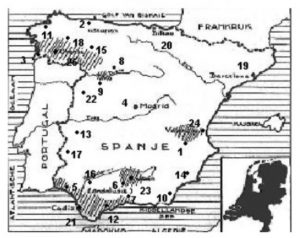
Most of the seamen (71) in our sample came from Galicia. This might indicate that shipping companies focused their recruitment efforts on this one region. However, a closer look at the places of origin of the sailors in our sample shows that almost half came from a few small villages: Muros (12 individuals, present-day population ca. 9,000), Ribeira (9 ind., pop. ca. 27,000), Carnota (6 ind., pop. ca. 4,000) and A Pobra do Caramiñal (5 ind., pop. ca. 10,000). These are all located in the strip of coastline to the north of Pontevedra, stretching all the way across the border of the neighboring province of La Coruña (see map below).
Our sample only contains seamen whose family name starts with the letter L. This might provide an explanation for the high concentration of Spanish sailors in the Dutch merchant marine from these villages: specific family names could be of frequent occurrence in small communities. We think, however, that it is also likely that informal networks were an important factor in the recruitment of Spanish seamen. This is supported by contemporary newspaper articles, which mention rumors of higher wages as motivation for traveling to the Netherlands and by the fact that the first Spanish sailors appear in our data set before the large-scale recruitment started: stories of the first few sailors probably persuaded friends and family to also try and find work at Dutch shipping companies.
Surinamese sailors
In his forty years of service, W.J. Lackin from Paramaribo in Suriname climbed through the ranks of the KNSM. How special was his career compared to other sailors from Suriname?
Some time ago Daniël wrote a blog post on the maritime career of W.J. Lackin. It illustrated how the story of his forty years of service at the Koninklijke Nederlandse Stoomboot-Maatschappij (KNSM) could be pieced together from various records from the company archives. As noted back then, his career was quite remarkable because of its length and high degree of social mobility. Lackin started out as a ‘matroos onder gage’ (sailor under wage) and eventually retired from a life at sea as a ‘gezagvoerder’ (captain). An interesting element left unexplored in the previous blog is his personal background. We know that Lackin was born in Paramaribo, but it is unclear to what extent his Surinamese origins were a factor in his career. Did others follow a similar path, or was he the exception to the rule?
Contrary to what you might think there is a challenge in determining the definition of a ‘Surinamese seamen’. Shipping companies only required the recording of a basic set of information for each employee. This included the place of birth, but ignored matters like cultural background. Someone born in the Netherlands to parents of Surinamese descent can therefore be hard to trace in our data. Limiting the definition to sailors born in Suriname also has the effect of including those born to parents of Dutch descent. Manually checking the background of each of the ca. 3.700 individuals in our data would of course be highly impractical. With this in mind it seems best to proceed with the aforementioned definition while taking into account these caveats.
Doing so results in 55 individuals from our data, born in Suriname between 1889 and 1952. These men served on ships of either KNSM, Koninklijke Rotterdamsche Lloyd (KRL) or Vereenigde Nederlandsche Scheepvaartmaatschappij (VNS) between ca. 1915 and 1973. A timeframe which roughly corresponds with the rest of our data.
Unsurprisingly, the vast majority (47) of these individuals were born in Paramaribo – the largest city of Suriname – with the rest almost evenly distributed between the areas of Boven Suriname (2), Commewijne (1), Marowijne (2) and Nickerie (2). For one of the sailors the place of birth was simply recorded as ‘Suriname’.
On average the seamen spent five years in service of the above-mentioned companies. It’s worth noting that this number is heavily skewed by the stats of a few individuals. Thirty-eight of the seamen were employed for four years or less, with eight of them leaving their job within a year of signing up. Life on board was certainly not everyone’s cup of tea. Several people seemed to have taken a liking to it however, with eight serving for ten years or longer. Three of those even spent thirty plus years at sea.
Areas of employment were split about evenly between those working on deck (such as sailors and carpenters) and those working below (engine or boiler room). The fact that several people appear to have switched between these two lines of work at some point is most likely indicative of the required amount of training. Many worked low-skilled jobs and career opportunities seem to have been limited. Only six of the Surinamese seamen held an officer’s rank, three of which ended their employment at the companies as an ‘assistent machinist’ or ‘assistent werktuigkundige’. Both of which refer to the (starter)position of assistant engineer, with the latter term coming into use over the former ca. 1950.
That is not to say that people could not progress within their line of work. Several individuals who started out as ship’s boys were eventually promoted to sailor. The chances of making the jump from the lower ranks to the officers appear to have been very slim however, with only two individuals recorded as having done so. One of these men subsequently left the company as ‘assistent machinist’, the other was W.J. Lackin.
In light of this information how does the career of Lackin compare? At this point it should probably come as no surprise that his path could be considered nothing less than extraordinary. Contrary to most of his peers he eventually managed to reach an officer’s rank after starting out as a sailor under wage. He then continued his steady advance before retiring as a captain after forty years of service at KNSM. In this regard his career truly stands out both for its length and social mobility.
Unfortunately archival records can only tell us so much. Although we can reconstruct what Lackin did, we can often only make educated guesses on why he did so and why he was able to do so. The latter is currently perhaps the most important unknown factor in his story. One that we hopefully can answer in the future.
Notes
Laurens Duijff
Eschel Juel
[ii] NL-HaNA, 1.04.02, inv. nr. 6325, nr. 9.
[iii] NL-SAA, 5075, inv. nr. 13009, nr. 201, 11 September 1760.
[iv] NL-SAA, 5075, inv. nr. 13009, nr. 201, 11 September 1760.
[v] NL-HaNA, 1.04.02, inv. nr. 6441, nr. 6.
[vi] NL-SAA, 5075, inv. nr. 13972, nr. 2295, 6 September 1770. Original text: Jongen. It could be that he meant ship’s boy.
[vii] NL-HaNA, 1.04.02, inv. nr. 6459, nr. 4; NL-HaNA, 1.04.02, inv. nr. 6459, nr. 9.
[viii] NL-SAA, 5075, inv. nr. 13972, nr. 2295, 6 September 1770.
[ix] NL-SAA, 5075, inv. nr. 13972, nr. 2295, 6 September 1770. Original text: Eschel Juel zeijde dat er niemand bij de geheele zeevaart zoo bequaam was om een schip door zee te brengen, als hij.
[x] NL-SAA, 5075, inv. nr. 13972, nr. 2295, 6 September 1770.
[xi] NL-SAA, 5075, inv. nr. 13972, nr. 2296, 6 September 1770.
[xii] NL-SAA, 5075, inv. nr. 11954, nr. 252, 31 August 1764.
[xiii] NL-SAA, 5075, inv. nr. 16364, nr. 106, 4 November 1777.
[xiv] NL-SAA, 5075, inv. nr. 16364, nr. 106, 4 November 1777.
Gabriel Lindt
[ii] Ruud Paesie, Geschiedenis van de MCC: opkomst, bloei en ondergang (Zutphen: WalburgPers, 2014) 96.
[iii] NL-MdbZA, 7357, inv. nr. 544, 14 November 1744. Original text: Varende man.
[iv] NL-MdbZA, 7117, inv. nr. 4547, 5 September 1745.
[v] NL-MdbZA, 7117, inv. nr. 4547, 8 April 1753.
[vi] NL-MdbZA, 20, inv. nr. 459, scan 0003.
[vii] Gerhard de Kok, Walcherse ketens. De trans-Atlantische slavenhandel en de economie van Walcheren, 1755-1780 (Zutphen: WalburgPers, 2020) 132.
[viii] NL-MdbZA, 20, inv. nr. 459, scan 0005. The third mate became second mate.
[ix] De Kok, Walcherse ketens, 134-135.
[x] NL-MdbZA, 20, inv. nr. 459, scan 0012.
Michiel Hendrik Kerke
[i] NL-HaNA, 1.04.02, inv. nr. 6185, nr. 60.
[ii] NL-SAA, 5001, inv. nr. 738, p. 24, 9 January 1761.
[iii] Some of these loans can be found in the archives of the CBG Verzamelingen. Centrum voor familiegeschiedenis. Most of the loans were, between 1763 and 1768, drawn up by different notaries (not all of them) and had a total value of at least 8996 guilders.
[iv] Christiaan van Bochove and Ton van Velzen, ‘Loans to salaried employees: the case of the Dutch East India Company, 1602-1794’, European Review of Economic History 18 (2013) 19-38; Willem-Jan van Grondelle, ‘Kredietverlening aan zeelieden in de achttiende eeuw. Particuliere geldleningen door VOC-opvarenden’, Tijdschrift voor Zeegeschiedenis 39:2 (2020) 34-38.
[v] NL-SAA, 5075, inv. nr. 10861, nr. 1429, 5 November 1771; NL-SAA, 5075, inv. nr. 10861, nr. 1428, 5 November 1771; NL-SAA, 5075, inv. nr. 14107, nr. 5832, 9 November 1771; NL-SAA, 5075, inv. nr. 14107, nr. 5833, 9 November 1771.
[vi] Danielle van den Heuvel, ‘Bij uijtlandigheijt van haar man’. Echtgenotes van VOC zeelieden, aangemonsterd voor de kamer Enkhuizen (1700-1750) (Amsterdam: Aksant, 2005) 34.
[vii] NL-SAA, 5075, inv. nr. 14315, nr. 546, 4 October 1768.
[viii] NL-SAA, 5075, inv. nr. 14335, nr. 132, 11 March 1775.
[ix] CBG, Inventory of the estate of Michiel Hendrik Kerke, 15 May 1773; Linda Mbeki and Matthias van Rossum, ‘Private slave trade in the Dutch Indian Ocean world: a study into the networks and backgrounds of the slavers and the enslaved in South Asia and South Africa’, Slavery & Abolition 38:1 (2017) 96.
[x] Jaap R. Bruijn, Schippers van de VOC in de achttiende eeuw. Aan de wal en op zee (Amsterdam: De Bataafsche Leeuw, 2008) 179-180.
[xi] Bruijn, Schippers van de VOC, 179.
[xii] NL-SAA, 5075, inv. nr. 14336, nr. 682, 21 October 1775.
Frans Otto
[i] NL-SAA, 5001, inv. nr. 720, p. 284, 8 April 1734.
[ii] NL-SAA, 5001, inv. nr. 247, p. 108, 18 September 1764.
[iii] NL-HaNA, 1.04.02, inv. nr. 6448, nr. 20; NL-HaNA, 1.04.02, inv. nr. 6483, nr. 14; NL-HaNA, 1.04.02, inv. nr. 6570, nr. 13.
[iv] NL-SAA, 5001, inv. nr. 247, p. 108, 18 September 1764; NL-SAA, 5001, inv. nr. 252, p. 123, 7 April 1769.
[v] NL-SAA, 5001, inv. nr. 1222, p. 85, 17 January 1773.
[vi] NL-HaNA, 1.04.02, inv. nr. 6570, nr. 13.
[vii] NL-SAA, 5075, inv. nr. 15291, nr. 29, 10 January 1776.
[viii] NL-HaNA, 1.04.02, inv. nr. 6570, nr. 13.
[ix] NL-HaNA, 1.04.02, inv. nr. 6570, nr. 13.
Spanish sailors
Thanks
We received generous funding from DutchCulture (Shared Cultural Heritage program) and the Samenwerkende Maritieme Fondsen.


